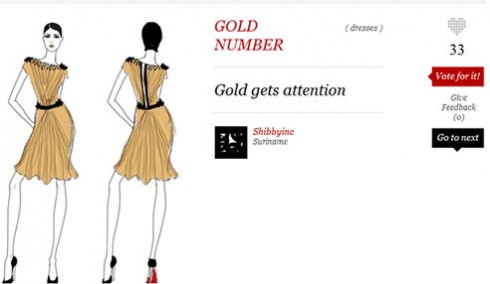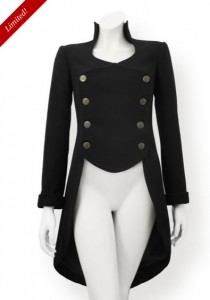Garmz Takes On Buy Now, Try Later Fashion: Startups @LeWeb
Pre-orders are nothing new to fashion. Many designers who don’t have the budgets for runway shows, PR campaigns and high gloss advertising rely on trunk shows where they can meet potential clients and take pre-orders.
Garmz, a 6-month-old startup from London, is among a growing list of websites banking on the internet to make pre-orders easier, reduce risk when it comes to mass production and excess inventory.

A design up for votes on Garmz
Burberry and Proenza Schouler are two established brands who’ve taken a similar approach, allowing customers to order items immediately after they appear on runways, so the idea of allowing demand to create supply is recent, but not totally new. Neither is the desire to allow emerging designers a platform to have their work seen – and eventually produced. “Democratize fashion,” is the popular tagline, and dozens of companies have tried in at least two dozen ways to put their spin on it with varying degrees of success and failure.
What then, is Garmz’s approach? Part community, part commerce, designers submit sketches to the Garmz website where users vote on their favorites. Once a design achieves popularity, the Garmz team reviews it to ensure it would be suitable for production (we’re guessing that means you won’t be able to order any Lady Gaga style meat dresses) and the designer is contacted to work through details for creating a prototype. Garmz then photographs the item, calculates the production price and puts it online for pre-orders. depending on the number of pre-orders, the piece moves into larger batch production where Garmz takes on the role of a traditional online retailer.

A Garmz produced jacket up for discounted pre-order
Designers receive 5% of the revenue on each piece sold. 5% doesn’t seem like much, but co-founder Andreas Klinger feels that Garmz still offers a unique advantage over other options that would give designers a larger cut. Etsy, for example, charges $0.20 for each item listed, and a 3.5% fee when an item sells. While that leaves a would-be designer with 95%+ of the sale, Klinger explains that Garmz is adding a layer of professional services in addition to a marketplace.
When a design on Garmz goes into production, the company handles everything from sourcing fabrics and textiles to mass production in Eastern Europe. Designers don’t have to learn about pattern making, finding production facilities or any of the things that are typically needed to move from individual items to commercial collection, and typically not covered in design schools.
Additionally there’s quality. Looking at some of the finished garments on display, there’s a consistency in fabrics and construction that can be elusive for designers starting out. The clothes aren’t couture, but wouldn’t be out of place among well-made secondary designer lines.
Our Thoughts
There are many creative talents who are never able to succeed in fashion because they never find the right business guidance to support their creativity. Threadless has shown that people will back up votes and social intent with purchases, and if Garmz can do something similar for designer fashion they could be a viable area of support for emerging talents who typically rely on grants, awards, and prizes to afford fabric, fashion shows and publicity.
Finding the funding to produce a label is a problem lots of would be designers face, but if Garmz wants to attract top-tier talent, an option that gives designers a larger share of sales (even if it also gives them a larger share of the risk) will probably become necessary.
Partnering with design schools could also be a good option. While Central Saint Martin’s, FIT and Parsons are renowned for their alumni, the number of design jobs at top fashion houses are limited and the economics behind building a successful business aren’t covered often enough. Retail and knowing how to sell are often the jobs that are available. Even if it doesn’t make them rich, a platform where designers could learn about marketing, manufacturing and other aspects could benefit the school, and give Garmz a continuous, high level of new talent which will be necessary to keep community interest high.
